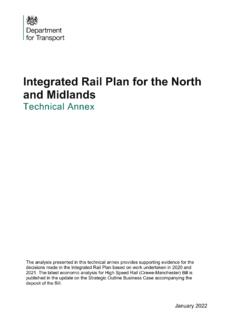Transcription of Introduction to EV Powertrain Function and Performance ...
1 Ricardo plc 2014 ARPA-E Range Kickoff Meeting 29 January 2014 Neil Johnson Associate Chief Engineer Hybrid & Electric Vehicles Introduction to EV Powertrain Function and Performance - from a Battery Perspective 2 Ricardo plc 2014 29 January 2014 ARPA-E RANGE Kickoff Introduction EV Powertrain Architecture Component Overview Vehicle Energy and Power Demands Getting Energy Into the Battery Range Specific Comments Outline 3 Ricardo plc 2014 29 January 2014 ARPA-E RANGE Kickoff Ricardo UK midlands Technical Centre Ricardo UK Cambridge Technical Centre Ricardo UK Shoreham Technical Centre Ricardo US Chicago Technical Centre Ricardo US Detroit Technical Centre Ricardo Germany Schw bisch Gm nd Ricardo Czech Republic Prague Ricardo India Delhi Ricardo in Italy Turin Ricardo Japan Yokohama Ricardo in Korea Seoul Ricardo in Malaysia Kuala Lumpur Ricardo in Russia Moscow Ricardo China Shanghai Ricardo - AEA Glengarnock Ricardo - AEA London Ricardo AEA Harwell Ricardo AEA Cardiff Established in 1915 and independent million revenue (FY 11/12) Additional million revenue from AEA Europe (FY 11/12) acquired on 8th November 2012 More than 2300 employees with over 2000 technical, scientific and engineering staff Global presence in 21 locations Introduction to Ricardo Our Business 2300 outstanding staff with an emphasis on transportation engineering plus related new energy and environmental sectors.
2 4 Ricardo plc 2014 29 January 2014 ARPA-E RANGE Kickoff Introduction EV Powertrain Architecture Component Overview Vehicle Energy and Power Demands Getting Energy Into the Battery Range Specific Comments Outline 5 Ricardo plc 2014 29 January 2014 ARPA-E RANGE Kickoff Globally China vehicle fleet to grow by the an amount equal to total US LD fleet2 by 2030; yet domestic oil production is only of US3 US US oil production peaked in 1970 s 2008 VMT ~3x 1970 Globally 100+ urban areas with 3+ million people-9 US Seattle = million 20+ mega-cities with over 10 million people US >100 million people live in counties with air quality below health based standard1 Decrease Local Pollution A quick reminder of why: 6+ billion people globally; all want increased mobility. Increase Energy Security Limit Global CO2 Globally Increasing pressure to reduce CO2 levels via Kyoto or other means US US EPA and NHTSA issued CO2 legislation in May 2010 for model year 2012-2016 LD vehicles Electric Vehicles Remove Transportation from The Above Debates 1 Our Nation's Air - Status and Trends through 2008, US EPA 2 Vehicle ownership and Income growth Worldwide, Energy Journal, 2007, Vol.
3 28, No. 4 3 CIA World Factbook 6 Ricardo plc 2014 29 January 2014 ARPA-E RANGE Kickoff Transportation Highly Dependent on Petroleum Utilizing Electricity Diversifies the Energy Supply 7 Ricardo plc 2014 29 January 2014 ARPA-E RANGE Kickoff Passenger Vehicles Sport Vehicles Commercial Vehicles Off-Highway & Military All world regions and vehicle applications are embracing or investigating electrification using a variety of architectures But only some are commercially viable today Toyota Prius (Japan) Tesla Roadster ( ) EfficientC ( ) Caterpillar ( ) Chevy Volt ( ) Ferrari 599 (Italy) John Deere ( ) Eletra Bus (Brazil) Think EV (Norway) Porsche 918 (Germany) Ricardo FTTS ( ) Smith EV ( ) Joule EV (S. Africa) McLaren F1 ( ) Oshkosh HEMTT ( ) Odyne ( ) 8 Ricardo plc 2014 29 January 2014 ARPA-E RANGE Kickoff In most EV s, there are 5 significant components that replace the Powertrain of a traditional vehicle: Electric machine Battery Pack Inverter Charger DC/DC Converter Introduction to EV Design High Voltage Component Overview Charger Inverter DC/DC 12V Battery Battery Pack - + Electric Machine 9 Ricardo plc 2014 29 January 2014 ARPA-E RANGE Kickoff The electric machine converts electricity to torque to move the vehicle.
4 There are many different designs but in very simple terms, they all utilize opposing electro-magnetic fields to create torque. At least one field is created by current through wire in the stator . The second field can be created by permanent magnets or a second wire pathway in the rotor. The torque is controlled by varying the current flow. Introduction to EV Design Component Overview Electric Machine Charger Inverter DC/DC 12V Battery Battery Pack - + Electric Machine Stator Rotor Permanent magnet electric motor from Nissan Leaf Images courtesy of A2 Mac1 & Ricardo s EV /Hybrid Analysis. 10 Ricardo plc 2014 29 January 2014 ARPA-E RANGE Kickoff ChargerInverterDC/DC12 VBatteryBattery Pack-+ElectricMachine Electric motor efficiencies are often well above 90% and are thus significantly more efficient than engines whose peak efficiency is down near 40%. Of course that means no free heat for our cars in the winter.
5 Electric motors also provide torque at 0 speed which allows one to design a vehicle with a single gear ratio between the electric motor and the tire rather than a multi-speed transmission. Introduction to EV Design Component Overview Electric Machine Source: Evaluation of 2005 Honda Accord Hybrid Electric Drive System , Oak Ridge National Lab, 2006 11 Ricardo plc 2014 29 January 2014 ARPA-E RANGE Kickoff The battery pack is the device for storing the energy that moves the vehicle. It must both accept and provide current to the electric machine as requested by the driver. The battery pack in an EV is a slave to driver demands. Hybrid vehicles can use their engine to adjust battery use when conditions warrant. Introduction to EV Design Component Overview Battery Pack Charger Inverter Battery Pack - + DC/DC 12V Battery Electric Machine Nissan Leaf Battery Pack Mitsubishi iMiEV Battery Pack Images courtesy of A2 Mac1 & Ricardo s EV /Hybrid Analysis.
6 12 Ricardo plc 2014 29 January 2014 ARPA-E RANGE Kickoff Battery packs provide direct current (DC) at their output terminals. Electric machines are controlled by varying an alternating current (AC) waveform. The motor inverter provides this conversion between DC and AC and the torque control functionality. Introduction to EV Design Component Overview Motor Inverter Charger Inverter Battery Pack - + DC/DC 12V Battery Electric Machine Mitsubishi iMiEV Inverter Nissan Leaf Inverter Images courtesy of A2 Mac1 & Ricardo s EV /Hybrid Analysis. 13 Ricardo plc 2014 29 January 2014 ARPA-E RANGE Kickoff Introduction to EV Design Component Overview DC/DC converter Charger Inverter DC/DC Converter Battery Pack - + 12V Battery Electric Machine EV s to date utilize the same 12 volt power system as traditional vehicles for low to moderate power electrical components. EV s don t have alternators like most vehicles with engines, so the 12 volt system power is supplied by the battery pack (with a 12V battery to supply transients).
7 A DC/DC converter is used to convert power from battery pack voltage down to 12 volts. Chevy Volt DC/DC Converter Images courtesy of A2 Mac1 & Ricardo s EV /Hybrid Analysis. 14 Ricardo plc 2014 29 January 2014 ARPA-E RANGE Kickoff An EV battery pack must be recharged, typically from the electric grid. The charger performs three functions: - Rectification of AC voltage from the grid to DC voltage - Controls the current flowing into the battery pack by controlling the DC output voltage - Communicates with the vehicle, off-vehicle equipment Bi-directional chargers allow energy transfer to the grid Introduction to EV Design Component Overview Charger (AC Charging) Charger Inverter DC/DC Converter Battery Pack - + 12V Battery Electric Machine Prius Plug-in Charger Images courtesy of A2 Mac1 & Ricardo s EV /Hybrid Analysis. 15 Ricardo plc 2014 29 January 2014 ARPA-E RANGE Kickoff DC charging is a phrase that describes the use of an off-vehicle charger.
8 The off-vehicle charger connects directly to the battery, bypassing the on-board charger. Robust communication is required between the vehicle and off-board charger. An off-vehicle, high power charger is utilized because high power chargers are too heavy to justify installation in the vehicle and too costly to dedicate to one vehicle. Introduction to EV Design Component Overview Charger (DC Charging) Charger Inverter DC/DC Converter Battery Pack - + 12V Battery Electric Machine 16 Ricardo plc 2014 29 January 2014 ARPA-E RANGE Kickoff Introduction EV Powertrain Architecture Component Overview Vehicle Energy and Power Demands Getting Energy Into the Battery Range Specific Comments Outline 17 Ricardo plc 2014 29 January 2014 ARPA-E RANGE Kickoff Power Flow During Portion of US Federal Test Procedure Vehicle Speed Battery Power 10kW 10 mph 18 Ricardo plc 2014 29 January 2014 ARPA-E RANGE Kickoff Battery Pack Performance Power Requirements for International Driving Cycles The battery output must also accommodate efficiency losses, high voltage accessories such as A/C & power steering, and the DC/DC converter.
9 These power levels are required across the entire temperature range. 19 Ricardo plc 2014 29 January 2014 ARPA-E RANGE Kickoff Battery Pack Performance Energy Requirements for International Driving Cycles Like the power values, efficiency losses and vehicle loads will increase these values. 400 mi interstate range requires ~150kW-hrs usable;1000+ kgs of today s battery 20 Ricardo plc 2014 29 January 2014 ARPA-E RANGE Kickoff Introduction EV Powertrain Architecture Component Overview Vehicle Energy and Power Demands Getting Energy Into the Battery Range Specific Comments Outline 21 Ricardo plc 2014 29 January 2014 ARPA-E RANGE Kickoff Charging from a standard wall plug Temporary installation Charging from a permanently wired AC supply Dedicated installation allows higher voltage & power than wall plug because a switch protects the outlet. Charging from a permanently wired off-vehicle charger Highest power levels Not supported by all PIV s PIV Charging Technologies Overview of three types of charging connectivity for on-vehicle and off-vehicle chargers1 Wall Outlet Charging Cable Vehicle AC Charging Inlet Wall Mounted Pole Mounted or Vehicle DC Charging Inlet 1 Industry is developing wireless charging, but systems are still in the research phases and are not likely to be in a production vehicle for >5 years.
10 Uses On-vehicle Charger Off-vehicle Charger 22 Ricardo plc 2014 29 January 2014 ARPA-E RANGE Kickoff PIV Charging Technologies Comparison of charging power levels (and gasoline fueling) (vehicle on-board charger &/or battery pack may limit actual power) a Assuming 350 W-hr/mile b Assuming 70 mph average highway driving speed c North American Limits d Assuming 350V battery pack Max. Voltage Max. Current Power Range Gain Fueling Time (Volts) (Amps) (kW) (miles/hr)a (% Drive Time)b AC Level I 120c (1f) 16 1280% AC Level II 240c (1f) 80 19 55 130% DC Level I 500 DC 80 40 80d 88% DC Level II 500 DC 200 100 200d 35% Mode 1 250 (1f) or 480 (3f) 16 22 320% Mode 2 250 (1f) or 480 (3f) 32 15 44 160% Mode 3 500 (3f) 250 125 360d 20% Mode 4 600 DC 400 240 400d 18% CHAdeMO 500 DC 100 50 100d 70% Tesla Supercharger 120 340 20% Gasoline at gas station @10 gal/min & 30 mpg 20,000 18,000 SAE J1772 IEC 62196-1 Today s fastest chargers still slow our driving down by 20% or more for long trips 23 Ricardo plc 2014 29 January 2014 ARPA-E RANGE Kickoff Introduction EV Powertrain Architecture Component Overview Getting Energy Into the Battery Using the Energy in the Battery RANGE Specific Comments Outline 24 Ricardo plc 2014 29 January 2014 ARPA-E RANGE Kickoff Range Specific Comments Nissan Leaf Battery Pack Assembly Pack 24 kW-hr & ~300 kg = 80 W-hr/kg Cell 125 W-hr & ~ = 147 W-hr/kg Images courtesy of A2 Mac1 & Ricardo s EV /Hybrid Analysis.




